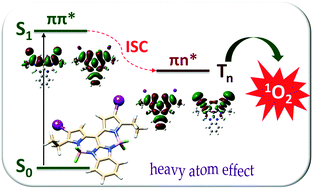Excitation energies, singlet–triplet energy gaps, spin–orbit matrix elements and heavy atom effects in BOIMPYs as possible photosensitizers for photodynamic therapy: a computational investigation†
Abstract
Bis(borondifluoride)-8-imidazodipyrromethene (BOIMPY) based molecules show interesting photophysical properties. We have undertaken a computational study at DFT and TDDFT levels of theory with the aim of verifying if the non-fluorescent BOIMPYs meet those properties necessary to be proposed as potential photosensitizers for photodynamic therapy (PDT). In particular, we have computed the absorption wavelengths, the singlet–triplet energy gaps and the spin–orbit matrix elements. The effect of halogen atom substitution (Br, I), in different amounts and positions in the BOIMPY skeleton, on the photophysical properties, has been elucidated. Some possible pathways for the population of the lowest triplet state have been examined and rationalized on the basis of Kasha rules. The results indicate that many of the studied systems can be indicated as potential photosensitizers for photodynamic therapy.



 Please wait while we load your content...
Please wait while we load your content...